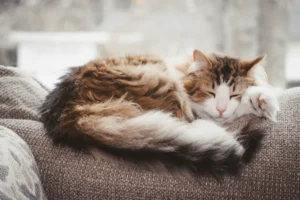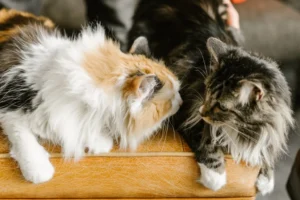Two cats screaming at each other can be quite a sight to behold. The chaos and intensity of their vocalizations can leave anyone wondering what could possibly be causing such a commotion. But fear not, for we are here to demystify the reasons behind why two cats may find themselves engaged in a vocal dispute.
The Importance of Cat Communication
Have you ever wondered why your two cats are screaming at each other? Well, let’s dive into the fascinating world of cat communication. Cats have a complex system of vocalizations, body language, and scent marking to communicate with each other and with their human companions. When two cats are screaming, they may be trying to convey a message to each other, whether it’s a warning to back off or a call for attention.
Cats use a variety of vocalizations, from meows to hisses, to express their feelings. Body language is also crucial for cats, as they can communicate through their posture, facial expressions, and tail movements. Additionally, cats use scent marking to establish their territories and communicate with other cats in the area.
When your two cats are screaming at each other, it might be a sign of conflict or misunderstanding. Understanding the importance of cat communication can help you decipher their messages and intervene if necessary. Pay attention to their vocalizations, body language, and scent markings to better understand what they are trying to convey.
Territory Disputes
Territory disputes are a common cause of cat confrontations. Cats are territorial animals by nature, and they have a strong instinct to protect their territory from intruders. When two cats from different territories come into contact, it can lead to vocal confrontations as they try to establish dominance and defend their space.
During a territorial dispute, cats may scream at each other to establish boundaries and assert their dominance. This behavior is a natural response to perceived threats to their territory. It’s essential for cat owners to recognize the signs of territorial aggression and take steps to help their cats feel secure in their environment.
To prevent territorial disputes between your cats, provide plenty of space and resources for each cat, such as separate feeding areas and litter boxes. By creating a harmonious environment for your feline companions, you can reduce the likelihood of conflicts over territory and promote peaceful coexistence.
Social Hierarchy
Cats are known to establish social hierarchies within their social groups, much like humans do in different social settings. When two cats are screaming at each other, it could be a result of a conflict over status within their group. Just like in any society, cats also have dominant individuals who may assert their status through vocalizations. These loud vocalizations serve as a way for cats to communicate and establish their rank within the group. It’s their way of saying, “I’m in charge here!” So, when you witness two cats engaged in a vocal showdown, it could be a power struggle over social hierarchy.
Mating Behavior
During the breeding season, mating behavior can lead to vocalizations between cats. Female cats in heat can yowl loudly to attract potential mates, and male cats may respond with their own vocalizations to signal interest. This can result in loud meowing, yowling, or even screaming between cats. The intense vocalizations during mating season are a natural part of feline behavior and can be quite normal. So, if you hear two cats screaming at each other, especially during certain times of the year, it could be related to their mating instincts kicking in.
Unique Insight: In addition to establishing dominance and mating behavior, cats may also scream at each other due to territorial disputes. Cats are territorial animals, and conflicts over territory can lead to loud vocalizations as they try to assert their ownership of a particular space. So, if you notice two cats screaming at each other in a specific area, it could be a territorial dispute that they are trying to resolve.
Fear and Aggression
When two cats are screaming at each other, fear and aggression could be at play. Cats can become scared or aggressive in certain situations, leading them to vocalize loudly to communicate their feelings. This may happen if one cat feels threatened by the other, such as when defending territory or resources. In these cases, the screaming serves as a warning or a way to establish dominance. It’s essential to create a safe and secure environment for your feline friends to reduce the likelihood of fear-based confrontations. Providing separate spaces, plenty of hiding spots, and individual resources can help alleviate these tensions and prevent unnecessary screaming matches.
Moreover, cats may also scream out of frustration or fear due to a medical issue. If you notice excessive or uncharacteristic vocalizations, it’s crucial to consult with a veterinarian to rule out any underlying health problems that may be causing distress or discomfort. Overall, addressing the root cause of fear and aggression can help minimize screaming behavior and promote harmony between your cats.
Unique Insight: Body Language
While vocalizations are a clear sign of fear or aggression, paying attention to your cats’ body language can provide valuable insights into their emotional state. Watch for signs like flattened ears, dilated pupils, raised fur, or a tense body posture, which can indicate stress, fear, or aggression. Understanding your cats’ body language can help you intervene effectively in tense situations and prevent escalating confrontations. By being attuned to their non-verbal cues, you can promote a peaceful coexistence and reduce the likelihood of vocal disputes.
Playful Behavior
Believe it or not, cats can engage in vocal play with each other, leading to loud screams that may sound alarming to us but are just part of their playful interactions. When cats are engaged in rough-and-tumble play, chasing each other, and play-fighting, they may emit loud vocalizations that mimic aggression but are actually a form of communication within the game. This vocal play can include growling, hissing, and, yes, screaming, without any real malice behind it.
It’s crucial to differentiate between genuine aggression and playful behavior to ensure a safe and enjoyable playtime for your cats. Providing engaging toys, interactive play sessions, and opportunities for physical activity can channel their energy into positive outlets and reduce the likelihood of loud vocalizations during play. Understanding the dynamics of feline play behavior can help you appreciate their vocalizations as part of a healthy, playful exchange.
Remember, just like humans communicate in various ways, cats have their unique vocal and body language to express themselves. By learning to interpret these signals, you can foster a harmonious environment where your furry companions can coexist peacefully.
Medical Issues
When cats are screaming at each other, it could be a sign of underlying medical problems. Medical issues such as pain, discomfort, or stress can cause cats to act out vocally. If you notice your cats engaging in loud confrontations, it’s crucial to rule out any health issues first. Regular vet check-ups can help identify and address any medical problems that may be contributing to their behavior.
Tips for Peaceful Coexistence
Creating a harmonious environment for your feline friends is essential to prevent them from screaming at each other. Establishing separate territories within your home can give each cat a sense of security and reduce the likelihood of conflicts. Provide plenty of vertical space like cat trees or shelves for climbing, allowing them to have their own space. Interactive playtime and positive reinforcement can also help build a stronger bond between your cats and minimize aggressive behaviors.
Tips for Peaceful Coexistence:
- Spay or Neuter: This can help reduce aggression and territorial behavior in cats.
- Regular Playtime: Engage your cats in interactive play sessions to release pent-up energy.
- Litter Box Maintenance: Ensure you have enough litter boxes for each cat and keep them clean to avoid stress.
- Routine Feeding Schedule: Establish a consistent feeding routine to reduce competition and potential conflicts over food.
- Consult a Professional: If the issues persist, consider seeking advice from a feline behavior specialist.
Alex, a passionate animal lover, has experience in training and understanding animal behavior. As a proud pet parent to two dogs and three cats, he founded AnimalReport.net to share insights from animal experts and expand his knowledge of the animal kingdom.




